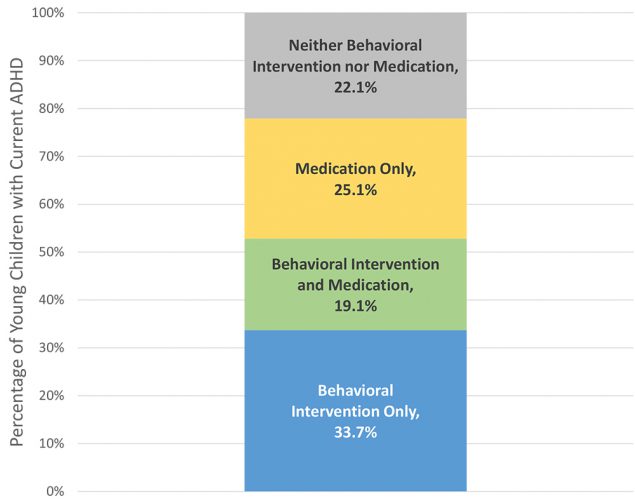Key Findings: A National Profile of Attention-Deficit / Hyperactivity Disorder Diagnosis and Treatment Among US Children Aged 2 to 5 Years

The Journal of Developmental and Behavioral Pediatrics has published a study that estimates the number of young children (2-5 years of age) who currently have attention-deficit/hyperactivity disorder, or ADHD, and the kinds of treatment these children received. This study is important because it is the first one to provide a national estimate of the number of children 2 to 5 years of age with ADHD in the United States.
CDC researchers found that in 2011-2012, approximately 237,000 children 2-5 years of age had an ADHD diagnosis, based on parent report. This is about 57% higher than the estimate for 2007-2008. Among these children, only about 50% received behavioral treatment for their ADHD. Read a summary of the article.
Main Findings
- In 2011 to 2012, approximately 237,000 children aged 2 to 5 years in the United States had an ADHD diagnosis, based on parent report.
- The number of young children with ADHD increased by more than 50% from the 2007-2008 survey.
- Of the nearly quarter of a million young children with ADHD in 2011 to 2012, over 100,000 of them had received the ADHD diagnosis before the age of 4 years.
- In 2011-12, more than half of young children with current ADHD had at least one co-occurring condition. The most common co-occurring conditions were developmental delays and behavioral disorders like oppositional defiant disorder or conduct disorder.
- Approximately 44% of young children with current ADHD were reported to be taking medication for ADHD.
- 53% of young children with current ADHD were reported to have received behavioral treatment in the past year.
Treatment Types among Young Children with ADHD

Some children are being diagnosed early with ADHD. Therefore, it is important to continue to monitor the number of these children and their treatment for ADHD to ensure these children receive the recommended first treatment for their age group: behavior therapy.
About The Study
The study used data from the National Survey of Children’s Health, a population-based telephone survey of parents that is designed to monitor the health of children living in the United States. This survey allowed researchers to produce weighted prevalence estimates of current ADHD among all U.S. children aged 2-5 years; and for those with current ADHD, the prevalence of medication treatment, ADHD severity, and presence of co-occurring conditions. Because the 2011 to 2012 National Survey of Children’s Health did not have any questions about behavior therapy for ADHD, we used a second data source to answer questions about behavioral treatment: the National Survey of Children with Special Health Care Needs, which was conducted in 2009 to 2010. Like the National Survey of Children’s Health, the National Survey of Children with Special Health Care Needs is a population-based telephone survey of parents, but it is restricted to parents of children with special healthcare needs (that is, children who meet a set of criteria for having a chronic condition and needing more medical or educational services than other children of the same age).
Reference
Danielson ML, Visser SN, Gleason MM, Peacock G, Claussen AH, Blumberg SJ. A National Profile of Attention-Deficit Hyperactivity Disorder Diagnosis and Treatment Among US Children Aged 2 to 5 Years. Journal of Developmental and Behavioral Pediatrics. 2017, 38(7), 455–464. Watch a video commentary on this study.
More Information
- Vital Signs: ADHD in young children
- Finding a Therapist: A Guide for Parents
- Behavior Therapy for Young Children with ADHD: Overview for parents
- Behavior Therapy for Young Children with ADHD: What healthcare providers can do
- ADHD treatment options
- National Resource Center on ADHD
- American Academy of Pediatrics clinical practice guideline for ADHD
- Webinar Series on Behavioral Parent Training for Young Children with ADHD – archived recordings available from the National Center on Behavioral Health
- I’m a parent of a young child with ADHD: Why do I need training in behavior therapy?
- Get the 4-1-1: Everything primary care providers should know about parent training in behavior therapy while working with families with young children with ADHD. (CME/CNE credits available)
- A clinician’s tale: How do I provide the best treatment for young children with disruptive behaviors, including ADHD? (CEU units available)
CDC’s National Center on Birth Defects and Developmental Disabilities (NCBDDD) is committed to helping children with ADHD and their families get the support they need. NCBDDD studies the prevalence of ADHD and current treatment practices, identifies factors that put children at risk for ADHD, and provides resources and information to parents, health providers, and state and local decision-makers, so that children and families can get the support they need as early as possible.






















.png)











No hay comentarios:
Publicar un comentario